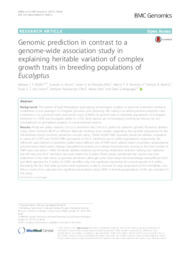Genomic prediction in contrast to a genome-wide association study in explaining heritable variation of complex growth traits in breeding populations of Eucalyptus.
Genomic prediction in contrast to a genome-wide association study in explaining heritable variation of complex growth traits in breeding populations of Eucalyptus.
Autoria: MÜLLER, B. S. F.; NEVES, L. G.; ALMEIDA FILHO, J. E. de; RESENDE JUNIOR, M. F. R.; MUÑOZ, P. R.; SANTOS, P. E. T. dos; PALUDZYSZYN FILHO, E.; KIRST, M.; GRATTAPAGLIA, D.
Resumo: Background: The advent of high-throughput genotyping technologies coupled to genomic prediction methods established a new paradigm to integrate genomics and breeding. We carried out whole-genome prediction and contrasted it to a genome-wide association study (GWAS) for growth traits in breeding populations of Eucalyptus benthamii (n =505) and Eucalyptus pellita (n =732). Both species are of increasing commercial interest for the development of germplasm adapted to environmental stresses. Results: Predictive ability reached 0.16 in E. benthamii and 0.44 in E. pellita for diameter growth. Predictive abilities using either Genomic BLUP or different Bayesian methods were similar, suggesting that growth adequately fits the infinitesimal model. Genomic prediction models using ~5000?10,000 SNPs provided predictive abilities equivalent to using all 13,787 and 19,506 SNPs genotyped in the E. benthamii and E. pellita populations, respectively. No difference was detected in predictive ability when different sets of SNPs were utilized, based on position (equidistantly genome-wide, inside genes, linkage disequilibrium pruned or on single chromosomes), as long as the total number of SNPs used was above ~5000. Predictive abilities obtained by removing relatedness between training and validation sets fell near zero for E. benthamii and were halved for E. pellita. These results corroborate the current view that relatedness is the main driver of genomic prediction, although some short-range historical linkage disequilibrium (LD) was likely captured for E. pellita. A GWAS identified only one significant association for volume growth in E. pellita, illustrating the fact that while genome-wide regression is able to account for large proportions of the heritability, very little or none of it is captured into significant associations using GWAS in breeding populations of the size evaluated in this study. Conclusions: This study provides further experimental data supporting positive prospects of using genome-wide data to capture large proportions of trait heritability and predict growth traits in trees with accuracies equal or better than those attainable by phenotypic selection. Additionally, our results document the superiority of the whole-genome regression approach in accounting for large proportions of the heritability of complex traits such as growth in contrast to the limited value of the local GWAS approach toward breeding applications in forest trees.
Ano de publicação: 2017
Tipo de publicação: Artigo de periódico
Unidade: Embrapa Florestas
Observações
1 - Por padrão são exibidas publicações dos últimos 20 anos. Para encontrar publicações mais antigas, configure o filtro ano de publicação, colocando o ano a partir do qual você deseja encontrar publicações. O filtro está na coluna da esquerda na busca acima.
2 - Para ler algumas publicações da Embrapa (apenas as que estão em formato ePub), é necessário ter, no celular ou computador, um desses softwares gratuitos. Sistemas Android: Google Play Livros; IOS: iBooks; Windows e Linux: software Calibre.
Acesse outras publicações
Acesse a Base de Dados da Pesquisa Agropecuária (BDPA) para consultar o acervo completo das bibliotecas da Embrapa.

